Adaptations
There are many, many, MANY different structures and behaviors
that Aconitum napellus has developed to become better
adapted to its environment. Here are I will discuss a few of them.
Firstly, stomata are a very beneficial adaptation of almost all
vascular plants. Stomata are specialized pores that are usually
located on the underside of the leaves. This is the main area of gas
exchange for the plant, and it helps to solve a variety of issues
like desiccation, gas exchange, and even water transport through the
plant. Firstly, stomata are surrounded by these special cells called
guard cells. These guard cells are what help to
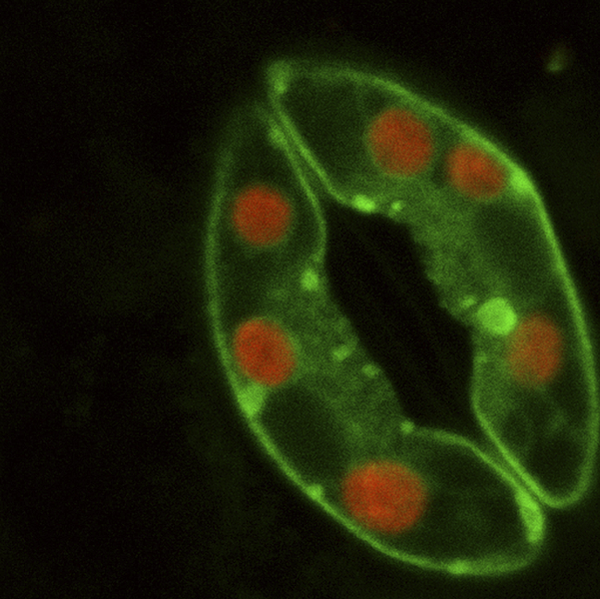 decide if the
stomata will remain open or closed to the environment. One clever
way I remember having these cells described to me is that they are
like two of those long-tubular balloons. When they are full of water
they expand and pull apart from each other, just like the balloons
would do if you filled them with air, meanwhile if they lose water
and become flaccid, they come together. This mechanism is how the
plant works to prevent losing any unnecessary water loss during
times of less rain or lower water levels. When the pores are open
the plant is able to get carbon dioxide from the atmosphere for
photosynthesis, but as it does this it also loses water. So, if
there is a shortage of water the guard cells spend more time in a
flaccid state, which keeps the stomata closed. Lastly, the stomata
are in a huge way responsible for the transportation of water up the
xylem from the roots to the rest of the plant. When the stomata are
open and water is evaporating from them a concentration gradient of
the water results, which then pulls the water up through the
vascular tissue to the top of the plant. This process of evaporation
is called transpiration, and it is a large part of what allows
plants like Aconitum napellus to grow as tall as they do
and still have water at the top of the plant!
decide if the
stomata will remain open or closed to the environment. One clever
way I remember having these cells described to me is that they are
like two of those long-tubular balloons. When they are full of water
they expand and pull apart from each other, just like the balloons
would do if you filled them with air, meanwhile if they lose water
and become flaccid, they come together. This mechanism is how the
plant works to prevent losing any unnecessary water loss during
times of less rain or lower water levels. When the pores are open
the plant is able to get carbon dioxide from the atmosphere for
photosynthesis, but as it does this it also loses water. So, if
there is a shortage of water the guard cells spend more time in a
flaccid state, which keeps the stomata closed. Lastly, the stomata
are in a huge way responsible for the transportation of water up the
xylem from the roots to the rest of the plant. When the stomata are
open and water is evaporating from them a concentration gradient of
the water results, which then pulls the water up through the
vascular tissue to the top of the plant. This process of evaporation
is called transpiration, and it is a large part of what allows
plants like Aconitum napellus to grow as tall as they do
and still have water at the top of the plant!
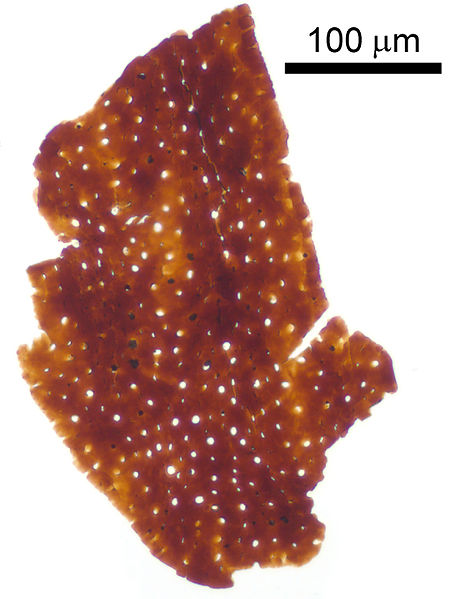
The cuticle is another important structural adaptation. This
structure is essentially the waxy coating on the outside of plant
leaves. This unique tissue is specially designed to help minimize
water loss, especially since the leaves are so highly vascularized
and have such large surface areas. Without the cuticle the leaf
would be able to lose water from all directions, and it would be
nearly impossible to regulate. This is extremely important in
helping plants keep enough water to function properly.
One of the special adaptations of Aconitum napellus is the
specialized poison it produces. This poison is mainly made as an
adaptation against predation. To hear more detail about the poison
and how it affects the creatures unfortunate enough to come across
it (humans included) click on the link here.
Xylem and phloem are another essential adaptation to all vascular
plants. To learn more about this type of plant and what makes them
different feel free to click here.
The xylem and phloem are specialized vascular tissues that help to
transport sugars, water, and nutrients all across the plant body.
They are primarily located in the stem-regions of the plant, and in
A. napellus they are organized into specialized areas called
vascular bundles. In A. napellus, along with other
eudicots, these bundles are all arranged in a ring near the outside
of the plant stem. Each bundle is consists of about half xylem and
half phloem tissue. The phloem layer is located on the half of the
bundle closer to the outside edge of the stem, whereas the xylem
layer takes up the half on the inside.
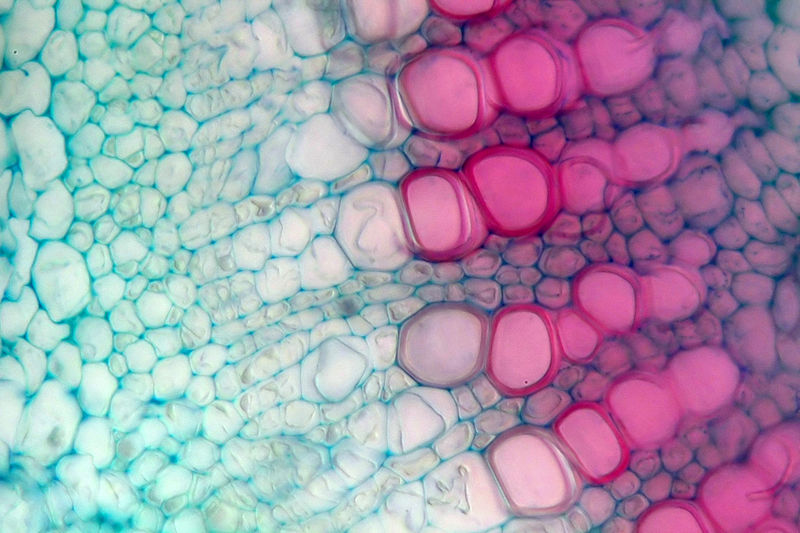
Phloem is the vascular tissue that transports most of the sugars and
nutrients of the plant. (In the picture it is the blue cells on the
left). The direction of flow is usually in a
downward direction from the leaves (site of photosynthesis) to the
roots which are continually growing with the plant. One important
thing to recognize, however, is that the flow of material in the
phloem is not unidirectional. A.k.a. The flow is not always from up
to down. The real rule to follow is that the phloem will always be
running from a source (a nutrient rich place) to a sink (a place
where nutrients are scarce or being used up very quickly). How the
current in phloem is generated is that at the source all of the
dissolved sugars and other substances are being actively pumped into
the sieve tube members of the phloem against their concentration
gradient. Then, in response to the increased solute concentration
within the sieve tube members, water flows into tubes causing an
increased pressure which pushes the water-sugar mixture down the
tube toward the destination. At the sink, the concentration of sugar
and nutrients in the cells surrounding the phloem is much lower than
those in the tubes, so the solutes diffuse out of the phloem into
the surrounding tissues, and the water follows. This creates a
negative pressure that also pulls the mixture down the tube to the
sink!
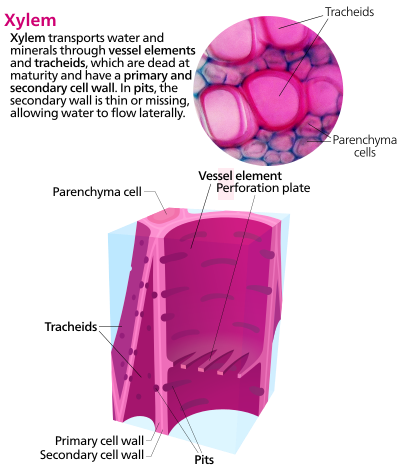
Xylem is the tissue in plants that transports water and nutrients
that the plant picks up from the soil. (In the picture it is the
pink cells on the right). In contrast to the phloem,
the xylem generally goes in a down to up direction. The xylem always
travels from the roots to the tip of the tree, so if a branch goes
off sideways or at an angle the xylem will go along with it. An
interesting thing about xylem tissue is that it is primarily dead
once it reaches maturity, meaning the cells transporting the water
are really just hollow tubes of fiber. Water moves through the xylem
through a combination of transpiration, adhesion, cohesion, and
tension. As I explained in the stomata paragraph, transpiration is
the evaporation of water from the plant through the stomata in the
leaves at the top of the plant. This creates a negative pressure for
the water which pulls more water upward to take the place of the
water that evaporated. Adhesion, cohesion, and tension are all
important in the formation of the water column that travels up the
xylem. The ability water has to stick to itself and the xylem cell
wall keeps the water in a cohesive chain that stays connected all
the way from the roots to the leaves of the plant.
As far as movement goes, Aconitum napellus is considered a
sessile organism in that it can’t just pick up its roots and walk
from one area to the next, but it does have the ability to grow and
react to stimuli in different directions.
How does it sense and react to stimuli? Well, rather than using
electrical signals like humans do to send their messages from one
part of the body to the other, plants such as Aconitum napellus
use chemical signals called hormones. Two of the most common
hormones in plants are auxin and cytokinin. Auxin is thought to be
responsible for a large amount of environmental reactions of the
plant, but it largely results in the general lengthening of the
plant cells. Cytokinins stimulate division of the plant cells.
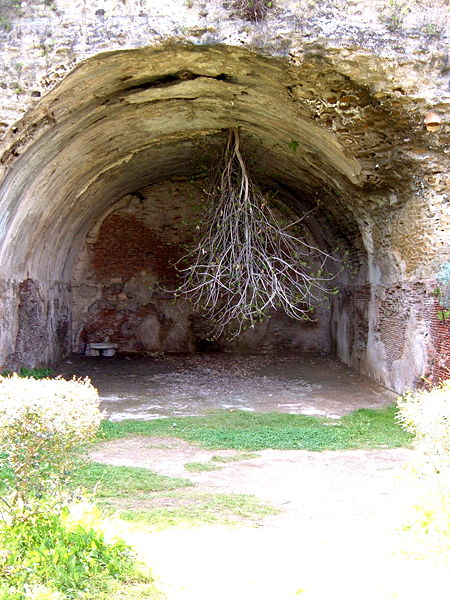
What kind of stimulus do plants react to? Well, plants react to many
different kinds of stimuli, but three of the most influential are
gravity, light, and touch. Gravity causes a response in plants
called gravitropism. Depending on what part of the plant you are in,
the response to gravity can either be to grow towards (positive gravitropsm) or away (negative gravitropism) from it. It is thought
that the concentration of auxin the plant parts are influential in
deciding whether a part of the plant will show negative or positive
gravitropism. The shoots, with the highest concentration of auxin,
generally grow away from gravity, meanwhile the roots with less
auxin generally grow toward it.
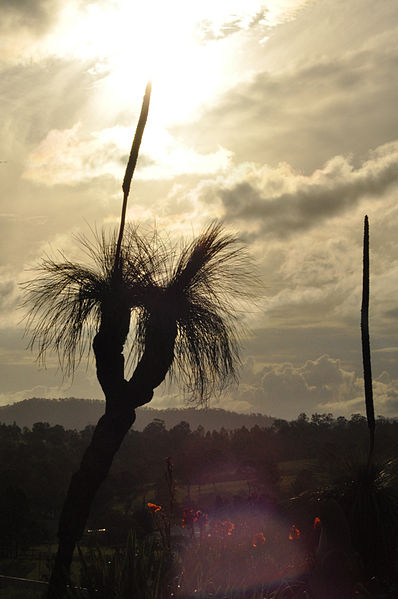
Light generates a response called phototropism. This response also
is closely related to the levels of the hormone auxin in the plant.
The light source on any side of the very tip of a plant increases auxin production in that area. Then once the auxin is made
it is transported to the opposite side of the plant. The increased
auxin levels there causes those cells to grow more and elongate,
which in turn bends the plant shoot toward the light!
Lastly, thigmotropism is the response generated by touch. A good
example that our professor, Dr. Volk, is that plants of the same species grown indoors tend to be
thinner, taller, and less stable than those grown outdoors. This is
because the plant outdoors is responding physically to the
environmental pressure of the wind that is not present indoors. The
cells of the outdoor plant expend more energy in their cell walls
and tend to have a broader, shorter structure than the cells of the
indoor plant. As a result, the indoor plant is able to spend more of
its energy growing upward which explains why they generally are able
to grow taller.
The structures of Aconitum napellus can help to tell the story of
how the plant functions. For instance the unique shape of this
plant’s flowers are made that way for a reason. The hooded structure
is a perfect shape for pollination by a bumblebee. The flower has
evolved to a shape that enables it to pass the most pollen possible
onto its primary pollinator as the insect feeds on its nectar,
resulting in more successful reproduction! To read more about the
relationship between A. napellus and the bumblebee or to
see an awesome video depicting the two organisms’ interaction with
one another click here.
The leaves of A. napellus along with other plants also make
a statement about their lifestyle. The thinness of the leaves make
it clear that the organism is trying to maximize surface area, in
this case t so that it can catch as much light possible for
photosynthesis.
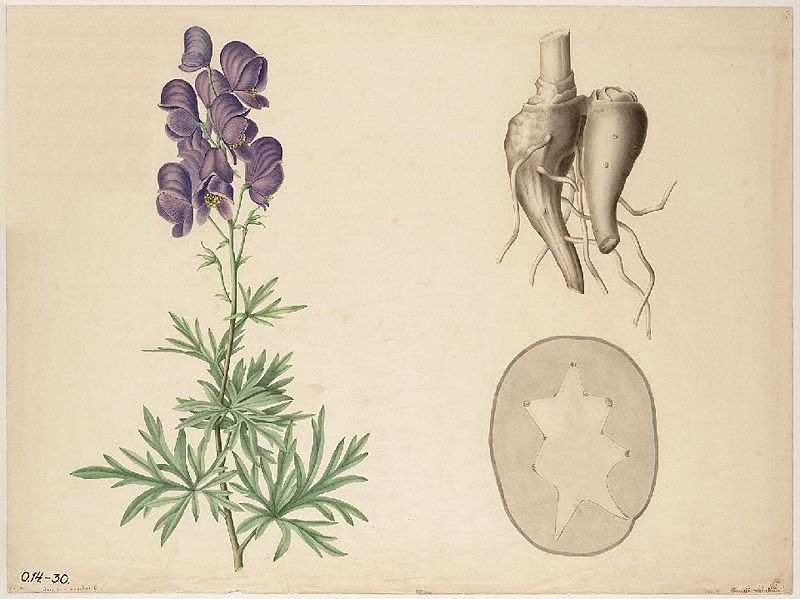
Finally, the morphology of the roots of A. napellus are
also strongly correlated to their function. All of the different
branches and shoots coming from the root help to increase the
available surface area. This gives the plant the ability to take in
more water and nutrients from the soil. If the root were just one
big mass the plant wouldn’t be able to grow nearly as big because it
would be impossible to take in enough of its metabolic necessities
from soil.
To sum it up, Aconitum napellus has acquired many traits
and adaptations to become better suited for its environment and to
better react to the signals around it, but that doesn’t mean that it
is perfect now by any means. A. napellus along with all
other species is constantly evolving to become an even better fit
with the world around it, and chances are that it always will be!
To go back to the home page click here.
